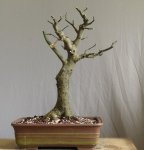pweifan
Shohin
Thank you! I'll have to try these out this spring. Any issues with them not holding the weight of a large tree?
Thank you! I'll have to try these out this spring. Any issues with them not holding the weight of a large tree?
I only use pond baskets for smaller trees that are in development. For larger trees in development I like using Anderson flats. 15 3/4" x 15 3/4" x 5" deep. They cost $3.50 each and last indefinitely.
View attachment 167234
I'm confused. I thought the idea to have the drainage on the sides and not necessary on the bottom?

How long do the colanders last? I am still thinking that for deciduous material, growing purposes it would be best to put in the ground or a regular pot. We know we can severely cut back the roots and it will survive. At the growing period we just care about growing roots and shoots as long as possible to beef up the trunk. Besides does Brent use colanders for any of his trees? Hasn't he been doing this for 20 years? Has to be a reason. I don't think the mesh bottom on that Anderson flat will last indefinitely. Maybe 10 years max. Unless you have some different experience?
I am still thinking that for deciduous material, growing purposes it would be best to put in the ground or a regular pot.
Im not so sure. I see alot of people using them for deciduous and im just wondering why. I think if the moisture content and oxygen content of your planting medium is adequate then you can use anything.I don't think using colanders was ever meant to be a catch-all for every kind of tree. It was mainly a technique for growing pines. Trees that can take more root work can likely be grown in the ground faster.
My experience with grow bags used in the ground has been poor. The roots tend to circle and grow back inward creating a difficult rootball to deal with. Containers that allow some roots to escape are an improvement. As stated above, the key is a system that works for your soil conditions and allows you to manage the periodic developmental work. Getting down to ground level to maintain trees is not for all age groupsI think a lot would depend on your soil. Something areas are going to be better than others for ground growing.
Ground growing is a skill as well. You can't just plunk a tree in the ground and hope for the best. The tree needs to be lifted periodically so that the roots can be worked and the tree needs to be chopped back to creat taper. The timing and frequency of each will effect how the tree progresses.




